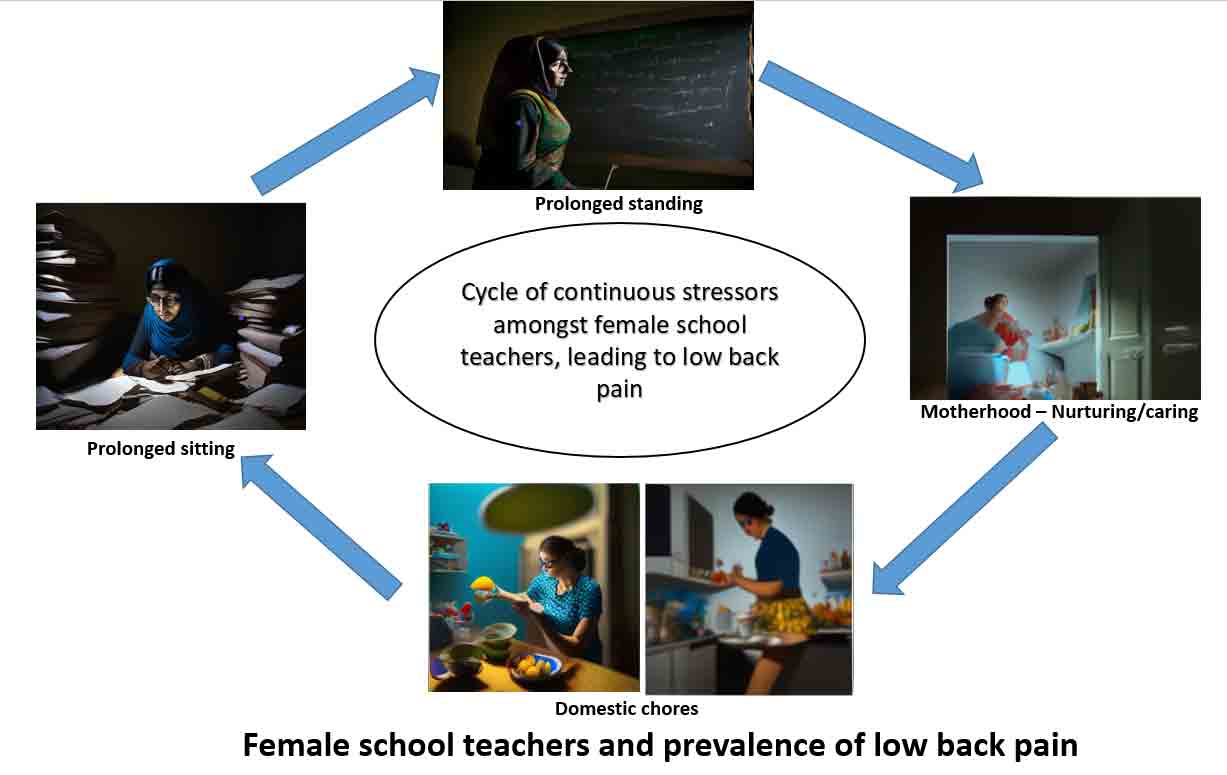Article Title :
A Geo-Medical Study of Low Back Pain Associated With Risk Factors Reported among Female School Teachers of Srinagar District, Jammu and Kashmir, India 
7 (2023)
21-30
Sitting Postures , School Teachers , prolonged standing , low back pain , Health Risk


Low Back Pain (LBP) is considered one of the most frequently reported causes of visits to healthcare establishments. In India, the prevalence of LBP is alarming with approximately 60% of people suffering from LBP. It has been observed that most people have experienced back discomfort at least once in their lives. Globally, LBP features amongst work-related disorders as a frequently prevailing issue in occupational settings. In the Indian scenario, the prevalence of LBP is generally found to be gender-specific. Females are reported to suffer more from LBP than males in the same working environment. Recent research suggests that school teachers exhibit a higher prevalence of LBP issues. Therefore, the present study focuses on enquiring about the occurrence of LBP and understanding the associated risk factors among female teachers. Simple random sampling is used to identify schools in 5 urban units of the Srinagar district. Binary logistic regression is employed to identify the risk factors, both at the workplace and at home. Married females (58.33 %) complained of LBP more than unmarried ones. At the workplace, prolonged standing (40%) was the most common self-reported risk factor for LBP. In general, prolonged standing, teaching hours, and mental health were found to be the three statistically significant risk factors contributing to LBP at the workplace. Amongst all the activities at home, domestic chores carried out by females (married and unmarried both) were the highest self-reported risk factor (78%), married women at 82.14% and unmarried women at 75.9%. The same was found statistically significant along with the additional factor being professional work done at home. The study establishes the need for a comprehensive strategy and preventive interventions in lowering the prevalence of LBP disability, especially among teachers, given the immense role they play in shaping our society.

Low Back Pain (LBP) is alarmingly prevalent in India, with approximately 60% of the population suffering from it.
Females tend to experience LBP more than males in the same working environment.
The study specifically investigates the occurrence of LBP and associated risk factors among female teachers.
Prolonged standing, teaching hours and mental health were identified as significant risk factors for LBP at the workplace.
Domestic chores carried out by both married and unmarried females were reported as the highest self-reported risk factor for LBP, along with professional work done at home.
The study emphasizes the importance of comprehensive strategies and preventive interventions to reduce the prevalence of LBP disability, especially among teachers.
Arju, A., 2018. The pattern of household activities and its effects on low back pain among housewives attended for physiotherapy treatment at CRP, Savar (Doctoral dissertation, Bangladesh Health Professions Institute, Faculty of Medicine, the University of Dhaka, Bangladesh.
Atlas, A. P., Bondoc, R. G., Garrovillas, R. A., Lo, R. D., Recinto, J., Yu, K. J. and PTRP, M. 2007. Prevalence of low back pain among public high school teachers in the City of Manila. Philippine Journal of Allied Health Sciences, 2(1), 34-40.
Azariah, P. S., Jaisheeba, A. A., Sornaraj, R., and Arinathan, V. 2011. High Prevalence of pain among the traditional salt workers of Thoothukudi. Journal of Ecotoxicology and Environmental Monitoring, 21(1), 71.
Barros, M. E., Zorzal, D. C., Almeida, F. S. D., Iglesias, R. Z., and Abreu, V. G. V. D., 2007. Saúde e trabalho docente: A escola como produtora de novas formas de vida. Trabalho, Educação e Saúde, 5, 103-124.
Cardoso, J. P., Ribeiro, I. D. Q. B., Araújo, T. M. D., Carvalho, F. M. and Reis, E. J. F. B. D., 2009. Prevalence of musculoskeletal pain among teachers. Revista Brasileira de Epidemiologia, 12, 604-614.
Chan, A. H. S., Chen, K. and Chong, E. Y. L., 2010 Work stress of teachers from primary and secondary schools in Hong Kong. Proceedings of the International MultiConference of Engineers and Computer Scientists. 3, 17
De Araújo, T. M., 2005. Mal-estardocente: Avaliação de condições de trabalho e saúdeemumainstituição de enino superior. Revistabaiana de saúdepública, 29(1), 6-6.
Hussain, M., andImtiyaz, I., 2016. Social impact of urbanization on the institution of family in kashmir: A study of Srinagar city. Communications, 24, 109.
Luttmann, A., Jager, M., Griefahn, B., Caffier, G. and Liebers, F., 2003. Preventing musculoskeletal disorders in the workplace.
Nazir, T., 2021. Women school teachers outnumber men for the first time in India. The Logical Indian.
Pervez, S. and Hanif, R., 2003. Levels and sources of work stress among women school teachers. Pakistan Journal of Psychological Research, 97-108
Rajgopal, T., 2000. Musculoskeletal disorders. Indian J Occup Environ Med, 4, 2-3.
Sampaio, M. D. M. F. and Marin, A. J., 2004. Precarização do trabalho docente e seus efeitos sobre as práticas curriculares. Educação and Sociedade, 25, 1203-1225.
Silman, A. J., 1987. Why do women live longer and is it worth it?. British medical journal, 294(6583), 1311.
Smith, D. R., Mihashi, M., Adachi, Y., Koga, H., and Ishitake, T., 2006. A detailed analysis of musculoskeletal disorder risk factors among Japanese nurses. Journal of Safety Research, 37(2), 195-200.
Tang, C. S. K., Au, W. T., Schwarzer, R. and Schmitz, G., 2001. Mental health outcomes of job stress among Chinese teachers: Role of stress resource factors and burnout. Journal of Organizational Behavior: The International Journal of Industrial, Occupational and Organizational Psychology and Behavior, 22(8), 887-901.
Yilmaz, Y., and Kaya, M., 2009. Risk factors for low back pain and its relation with pain-related disability and depression in a Turkish sample. Turkish Neurosurgery, 19(4), 327-332.






